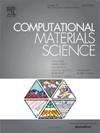Cluster transport induced by a thermal gradient on a crystalline surface
IF 3.1
3区 材料科学
Q2 MATERIALS SCIENCE, MULTIDISCIPLINARY
引用次数: 0
Abstract
Using molecular dynamic (MD) simulations, we study the thermomigration of small clusters consisting of 2, 3 or 4 atoms on a crystalline surface. After evidencing the thermomigration by analyzing the cluster trajectories, we generalize the thermodynamic integration method to compute a thermodynamic potential driving the probability of presence of the clusters on a substrate submitted to a thermal gradient. The study of this thermodynamic potential allows to disentangle the thermomigration effective force from the stochastic diffusion. We show that the heat of transport characterizing the effective force responsible for thermomigration is the sum of the free energy of the cluster–substrate and cluster internal energies. Finally, an unidimensional kinetic model for the thermomigration is proposed and its results compared to the MD trajectories.

求助全文
约1分钟内获得全文
求助全文
来源期刊

Computational Materials Science
工程技术-材料科学:综合
CiteScore
6.50
自引率
6.10%
发文量
665
审稿时长
26 days
期刊介绍:
The goal of Computational Materials Science is to report on results that provide new or unique insights into, or significantly expand our understanding of, the properties of materials or phenomena associated with their design, synthesis, processing, characterization, and utilization. To be relevant to the journal, the results should be applied or applicable to specific material systems that are discussed within the submission.
 求助内容:
求助内容: 应助结果提醒方式:
应助结果提醒方式:


